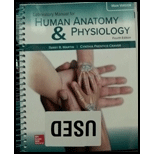
Laboratory Manual For Human Anatomy & Physiology
4th Edition
ISBN: 9781260159080
Author: Martin, Terry R., Prentice-craver, Cynthia
Publisher: Mcgraw-hill Education,
expand_more
expand_more
format_list_bulleted
Textbook Question
Chapter 26, Problem 3PL
Which of the following is a bony feature of the upper torso?
a. pectoralis major
b. anterior axillary fold
c. jugular notch
d. deltoid
Expert Solution & Answer
Want to see the full answer?
Check out a sample textbook solution
Students have asked these similar questions
What is the clinical significance of the following:
a. pericardial cavity
b. boundaries of femoral triangle
c. greater omentum
The viscerocranium includes:- a. The maxilla. b. The parietal bones. c. The occipital bone. d. The temporal bone. e. The atlas.
Which Structures originate under the SMAS?
Select one or more:
a. Zygomaticus major
b. Mandibular ligament
c. Orbicularis oris
d. Orbicularis oculi
e. Maxillary ligament
Chapter 26 Solutions
Laboratory Manual For Human Anatomy & Physiology
Ch. 26 - The technique of examining surface features with...Ch. 26 - Soft tissues include the following except a. bone....Ch. 26 - Which of the following is a bony feature of the...Ch. 26 - Which of the following is a soft tissue feature of...Ch. 26 - Palpation enables us to determine all of the...Ch. 26 - The laryngeal prominence can be palpated in the...Ch. 26 - The lineaalba is a feature of the posterior torso...Ch. 26 - It is important that healthcare professionals have...Ch. 26 - Match the body regions in column A with the...Ch. 26 - FIGURE 26.9 Using the terms provided, label the...
Knowledge Booster
Learn more about
Need a deep-dive on the concept behind this application? Look no further. Learn more about this topic, biology and related others by exploring similar questions and additional content below.Similar questions
- The bone of the arm located on the thumb side is called thea. ulna.b. radius.c. humerus.d. carpal.arrow_forwardWhich of the following is NOT a cranial suture? A. Coronal B. Epiphyseal C. Sagittal D. Squamous E. Lambdoidalarrow_forwardPutting It All Together A. Humerus B. Brachialis C. Biceps brachii D. Triceps brachii (long head) E. Triceps brachii (medial head) F. Triceps brachii (lateral head) Lateral Posteriorarrow_forward
- Mark the following statements as true or false. If a statement is false, correct it to make a true statement.a. The thoracic and sacral curvatures are the vertebral column’s convex curvatures.b. A vertebral disc is composed of an inner anulus fibrosus and an outer nucleus pulposus.c. The posterior projection from a vertebra is the spinous process.d. The sacral, coccygeal, and cervical vertebrae are fused in an adult.arrow_forwardMatch the following statements with the corresponding sutures being described. Divides the parietal bone into left and right A. Squamous suture portions B. Sagittal suture Separates the frontal and parietal bones C. Coronal suture Separates the occipital and parietal bones D. Lambdoid suture v Separates the temporal and parietal bonesarrow_forwardmatch the correct ans Column A Column B 1. Head of the humerus a.) Articulating surface at a joint 2. Foramen ovale in the skull b.) Attachment site for tendons or ligaments 3. Trochanter in the femur c.) Passageway for nerves or blood vessels 4. Costal facet in the thoracic vertebra 5. Mastoid process in the skull 6. Carotid canal in the skullarrow_forward
- The bone that forms the base of the skull is thea. parietal.b. temporal.c. occipital.d. frontal.arrow_forwardMark the following statements as true or false. If a statement is false, correct it to make a true statement. a. The four paranasal sinuses are the frontal, parietal, sphenoidal, and mandibular sinuses. b. The cribriform plate is a component of the ethmoid bone. c. The sella turcica of the sphenoid bone houses the pituitary gland. d. The styloid process of the temporal bone is a thick, posterior projection. e. The most conspicuous feature of the temporal bone is the foramen magnum.arrow_forwardThe key bone of the skull is the a. ethmoid. b. frontal. c. parietal. d. sphenoid.arrow_forward
- Label the following numbers: 30 & 32 of the skull in the inferior viewarrow_forwardA normal vertebral column shows a slight “S” shape in the sagittal plane: Group of answer choices a. ) True b.) False Which of the following statements correctly describes the ribs: Anteriorly, the ribs attach to the: Group of answer choices a. mandibulum and vertebrae of the thorax b. sternum, costal cartilage, or float c. vertebrae and to the costal cartilage d. clavicles, scapula, or float (unattached)arrow_forwardMark the following statements as true or false. If a statement is false, correct it to make a true statement. a. The obturator foramen articulates with the head of the femur at the hip joint. b. The superior border of the coxal bone is the iliac crest. c. The weight of the body in the sitting position is borne by the ischial tuberositiesarrow_forward
arrow_back_ios
SEE MORE QUESTIONS
arrow_forward_ios
Recommended textbooks for you
- Basic Clinical Lab Competencies for Respiratory C...NursingISBN:9781285244662Author:WhitePublisher:Cengage
 Medical Terminology for Health Professions, Spira...Health & NutritionISBN:9781305634350Author:Ann Ehrlich, Carol L. Schroeder, Laura Ehrlich, Katrina A. SchroederPublisher:Cengage Learning
Medical Terminology for Health Professions, Spira...Health & NutritionISBN:9781305634350Author:Ann Ehrlich, Carol L. Schroeder, Laura Ehrlich, Katrina A. SchroederPublisher:Cengage Learning

Basic Clinical Lab Competencies for Respiratory C...
Nursing
ISBN:9781285244662
Author:White
Publisher:Cengage



Medical Terminology for Health Professions, Spira...
Health & Nutrition
ISBN:9781305634350
Author:Ann Ehrlich, Carol L. Schroeder, Laura Ehrlich, Katrina A. Schroeder
Publisher:Cengage Learning
The Skeletal System; Author: Professor Dave Explains;https://www.youtube.com/watch?v=f-FF7Qigd3U;License: Standard YouTube License, CC-BY